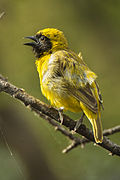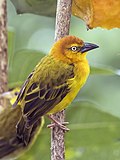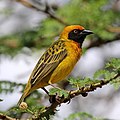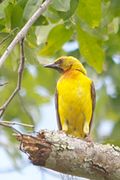| Image | Common name | Scientific name | Distribution |
|---|
 | Baglafecht weaver | Ploceus baglafecht | highlands of equatorial Africa |
 | Bannerman's weaver | Ploceus bannermani | Western High Plateau |
 | Bates's weaver | Ploceus batesi | Cameroon. |
| Black-chinned weaver | Ploceus nigrimentus | Bailundu Highlands of western Angola, on the Batéké Plateau in Republic of the Congo, and in eastern Gabon. |
 | Bertram's weaver | Ploceus bertrandi | Malawi, Mozambique, Tanzania, and Zambia. |
 | Slender-billed weaver | Ploceus pelzelni | equatorial Africa |
 | Loango weaver | Ploceus subpersonatus | maritime Central Africa |
 | Little weaver | Ploceus luteolus | western Sudan (region) and East Africa |
 | Spectacled weaver | Ploceus ocularis | Sub-Saharan Africa (except west, south, Horn of Africa and Madagascar) |
 | Black-necked weaver | Ploceus nigricollis | equatorial Africa |
 | Olive-naped weaver | Ploceus brachypterus | West Africa |
 | Strange weaver | Ploceus alienus | Albertine Rift montane forests. |
 | Black-billed weaver | Ploceus melanogaster | central Africa. |
 | Cape weaver | Ploceus capensis | southern Africa. |
 | Bocage's weaver | Ploceus temporalis | Angola, southern Democratic Republic of the Congo and northwestern Zambia. |
 | Eastern golden weaver | Ploceus subaureus | highlands of eastern and south-eastern Africa. |
 | Holub's golden weaver | Ploceus xanthops | miombo and adjacent areas |
 | Orange weaver | Ploceus aurantius | African tropical rainforest. |
 | Heuglin's masked weaver | Ploceus heuglini | Senegal, Gambia and Mali to Ivory Coast and east to Uganda and western Kenya. |
 | Golden palm weaver | Ploceus bojeri | eastern Africa. |
 | Taveta weaver | Ploceus castaneiceps | African Savannah in Kenya and Tanzania. |
 | Príncipe weaver | Ploceus princeps | São Tomé and Príncipe |
 | Northern brown-throated weaver | Ploceus castanops | Uganda, Rwanda and adjacent northern Burundi, eastern Democratic Republic of the Congo, western Kenya and northwestern Tanzania. |
 | Southern brown-throated weaver | Ploceus xanthopterus | southern Africa. |
| Ruvu weaver | Ploceus holoxanthus | Tanzania |
| Kilombero weaver | Ploceus burnieri | Tanzania |
 | Rüppell's weaver | Ploceus galbula | eastern Africa and southwestern Arabian Peninsula |
 | Northern masked weaver | Ploceus taeniopterus | Democratic Republic of the Congo, Ethiopia, Kenya, and Sudan. |
 | Lesser masked weaver | Ploceus intermedius | eastern, south-eastern and southern Africa. |
 | Southern masked weaver | Ploceus velatus | southern Africa. |
 | Katanga masked weaver | Ploceus katangae | south-eastern Democratic Republic of the Congo and northern Zambia. |
| Lufira masked weaver | Ploceus ruweti | Democratic Republic of the Congo. |
| Tanzanian masked weaver | Ploceus reichardi | south-western Tanzania and north-eastern Zambia. |
 | Vitelline masked weaver | Ploceus vitellinus | western, central and eastern Africa. |
 | Speke's weaver | Ploceus spekei | northern and eastern Somalia, Ethiopia, Kenya, and north-eastern Tanzania |
 | Fox's weaver | Ploceus spekeoides | Uganda. |
 | Village weaver | Ploceus cucullatus | Sub-Saharan Africa; introduced to Hispaniola, Dominica, Mauritius and Réunion. |
 | Giant weaver | Ploceus grandis | São Tomé Island. |
 | Chestnut-and-black weaver | Ploceus castaneofuscus | West Africa |
 | Vieillot's black weaver | Ploceus nigerrimus | Central Africa |
 | Weyns's weaver | Ploceus weynsi | eastern Democratic Republic of the Congo and north-western Tanzania. |
 | Kilifi weaver | Ploceus golandi | Kenya. |
 | Juba weaver | Ploceus dichrocephalus | Horn of Africa. |
 | Black-headed weaver | Ploceus melanocephalus | West, Central, and East Africa |
 | Golden-backed weaver | Ploceus jacksoni | Burundi, Kenya, South Sudan, Tanzania, and Uganda. |
| Cinnamon weaver | Ploceus badius | Sudan and South Sudan |
 | Chestnut weaver | Ploceus rubiginosus | eastern and south-western Africa. |
| Golden-naped weaver | Ploceus aureonucha | northeastern Democratic Republic of the Congo. |
 | Yellow-mantled weaver | Ploceus tricolor | African tropical rainforest. |
 | Maxwell's black weaver | Ploceus albinucha | African tropical rainforest. |
 | Nelicourvi weaver | Ploceus nelicourvi | Madagascar |
 | Sakalava weaver | Ploceus sakalava | Madagascar. |
 | Asian golden weaver | Ploceus hypoxanthus | Cambodia, Indonesia, Laos, Myanmar, Thailand, and Vietnam. |
 | Black-breasted weaver | Ploceus benghalensis | South Asia |
 | Streaked weaver | Ploceus manyar | Bangladesh, Bhutan, Cambodia, China, Egypt, India, Indonesia, Myanmar, Nepal, Pakistan, Singapore, Sri Lanka, Thailand, Vietnam |
 | Baya weaver | Ploceus philippinus | Indian Subcontinent and Southeast Asia. |
 | Finn's weaver | Ploceus megarhynchus | India and Nepal |
 | Dark-backed weaver | Ploceus bicolor | Sub-Saharan Africa (except west, south, Horn of Africa and Madagascar) |
 | Preuss's weaver | Ploceus preussi | Cameroon, Central African Republic, Republic of the Congo, DRC, Ivory Coast, Equatorial Guinea, Gabon, Ghana, Guinea, Liberia, and Sierra Leone. |
| Yellow-capped weaver | Ploceus dorsomaculatus | Cameroon, Central African Republic, Republic of the Congo, Democratic Republic of the Congo, and Gabon. |
 | Olive-headed weaver | Ploceus olivaceiceps | Malawi, Mozambique, Tanzania, and Zambia. |
| Usambara weaver | Ploceus nicolli | Tanzania. |
 | Brown-capped weaver | Ploceus insignis | Western High Plateau, Albertine Rift montane forests, Imatong Mountains and Kenya |
 | Bar-winged weaver | Ploceus angolensis | Angola, Democratic Republic of the Congo, and Zambia. |
 | São Tomé weaver | Ploceus sanctithomae | São Tomé and Príncipe. |
| Yellow-legged weaver | Ploceus flavipes | Democratic Republic of the Congo. |
|

































































